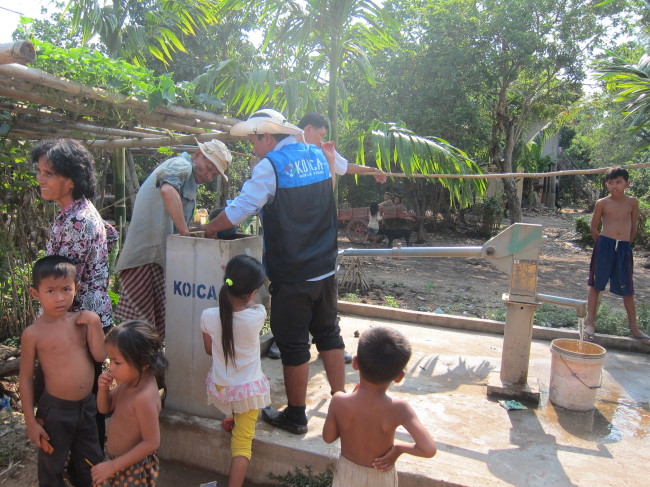PHNOM PENH (The Korea Herald)― With agriculture still the mainstay of its economy, Cambodia is seeking to reform rural communities in partnership with Korea to shore up residents’ livelihoods and boost grain exports.
The Southeast Asian country is seeking to follow in the footsteps of the “Saemaeul Undong,” or New Community Movement, a rural reform drive in Korea in the 1970s and 1980s. The two countries agreed in June to build a training institute and carry out pilot projects in 30 villages by 2018, for which Seoul pledged $8 million in grant aid.
Though smaller-scale pilot programs have been conducted in the past, the five-year initiative marks the first-ever nationwide demonstration of the movement.
“This program has two goals: safety and social protection,” Deputy Prime Minister Yim Chhay Ly said during an interview with visiting Korean reporters.
“We’re trying to identify important programs for community development, and to reduce the gap between urban and rural areas though programs to assist with rural development.”
The Korea International Cooperation Agency, the country’s grant aid institution, plans to provide consultations and training for central and local government officials, as well as village leaders. The deputy premier himself traveled to Korea twice this year alone, touring the cradle of the movement, as well as training facilities and industrial complexes.
The tentatively named SMU Training Center, to be launched early next year in Kampong Speu, some 70 kilometers west of the capital, will include lecture rooms, laboratories and a dormitory and be capable of accommodating up to 100 trainees at a time.
 |
| Volunteers of the Korea International Cooperation Agency and local residents work together to dig a well in Kampong Cham province, Cambodia. (KOICA) |
The fledgling project will also help the country achieve its 2014-18 National Strategic Development Plan, designed to promote partnerships and jack up development effectiveness, officials noted.
“We acknowledge that the Saemaeul Undong can let us raise living standards and improve the macroeconomy, which is a basic fundamental in developing a country,” Yim Chhay Ly said.
“In the past, say, people could produce only 1 ton. But because now we have water, fertilizer and so forth, so they can produce a lot more than that. Thanks to an irrigation scheme supported by KOICA we have better management, producing more rice and lifting poverty.”
Controversy, however, persists over whether the Saemaeul movement can work long-term without foreign support and uniform application, which defies the international community’s long-cherished priority of customized assistance.
A growing number of activists say that almost identical programs are under way around the world, which consist of building a village hall, renovating houses and bathrooms, digging wells, cultivating cropland and setting up fish or poultry farms, but they lack a clear long-term goal and detailed action plans.
During the selection process for pilot projects, many of the officials trained in Korea have taken flak for putting political gains ahead of the needs in the field or their urgency, picking their hometowns or other places they are connected to.
“As we learn from the Saemaeul Undong and Korea’s experience, if something’s not good, we’ll benchmark it in implementing our own program,” the deputy premier said.
“What we understand is that the Saemaeul Undong in Korea had so many areas and goals. Here we’re focusing more on agricultural aspects, such as rural credit and the establishment of rural village committee. We’ve adopted it and need to modify it in the context of Cambodia.”
Relations between the two countries have in recent years been improving on the back of upbeat growth in Seoul’s official development assistance and people-to-people exchanges.
Korea is Cambodia’s fifth-largest source of ODA, after China, Japan, the U.S. and Australia, funneling about $516 million into the country since 1991. It finances infrastructure development, health care, education, as well as the Saemaeul Undong project.
Last year, the number of Korean tourists to Cambodia neared 433,000, up more than 5 percent from the year before. Korea is Cambodia’s second-biggest source of foreign travelers following Vietnam.
“Korea’s commitment grows every year, contributing to Cambodia’s economic development and poverty reduction,” said Im Sour, deputy secretary-general at the Council for the Development of Cambodia.
“In addition to hard and soft assistance … Korea provides lots of volunteers. They’re hardworking in Cambodia not only in Phnom Penh but also in remote areas, transferring knowledge to local people and promoting teachers and students.”
By Shin Hyon-hee, Korea Herald correspondent
(heeshin@heraldcorp.com)

No comments:
Post a Comment